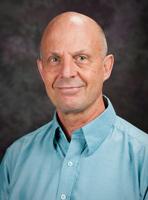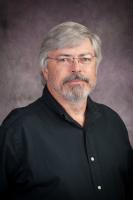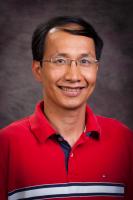NSF REU at K-State: Interactions of Matter, Light and Learning
The K-State REU program offers summer fellowships to do world-class research in our friendly physics department in the scenic Flinthills. We are funded by the National Science Foundation.
Atomic, Molecular & Optical Physics (AMO)
 Dr. Itzik Ben-Itzhak: Enhancing the photon flux of high harmonic generation using a two-color driving laser field
Dr. Itzik Ben-Itzhak: Enhancing the photon flux of high harmonic generation using a two-color driving laser field
Email: ibi@phys.ksu.edu
High harmonic generation (HHG) is a promising process for producing ultrashort VUV to soft X-ray laser pulses and is the foundation of the field of attosecond (10-18 s) science. It has been experimentally demonstrated that HHG can be used to produce <100 attosecond pulses [1], faster than the orbital period of an electron in the Bohr model of hydrogen! This short duration enables the imaging of electron dynamics in atoms and molecules on their fundamental time scales.
The types of experiments that can be performed employing HHG laser pulses is limited by their low photon flux due to the inefficient HHG process. To combat this restriction, experiments are currently underway in the James R. Macdonald Laboratory aimed at increasing the harmonic flux by simply using a stronger driving laser field. This is possible with the new HITS laser [2], which provides 26 fs laser pulses with a central wavelength of 800 nm and 20 mJ of energy per pulse, about an order of magnitude higher pulse energy than many "conventional" ultrafast laser systems.
The goal of the project1 in which the REU student will be involved is to further enhance the harmonic yield by using a high energy laser field composed of two colors, namely 800 and 400 nm. The project will include designing, aligning and calibrating the two-color setup, planning and conducting new measurements, and analyzing the data until the results are understood well enough to report them in a scientific publication. The student will be mentored by Professor Itzik Ben-Itzhak and his graduate student Travis Severt2. We may explore additional experiments employing this two-color setup if the development proceeds rapidly.
[1] Goulielmakis et al., Science 320, 1614 (2008).
[2] Langdon et al., Optics Express 23, 4563 (2015).
____________________________
1 Conducted in collaboration with the group of Professor Carlos Trallero
2 Previous REU participant in 2011
 Dr. Brett DePaola
Dr. Brett DePaola
Email: depaola@phys.ksu.edu
I have two "in-house" research efforts right now: (1) Using MOTRIMS to differentiate between competing processes of amplified spontaneous emission (ASE) and four wave mixing (FWM) in the production of blue light from rubidium vapor. (2) Developing embedded electronics for several applications.
1. Distinguishing between ASE and FWM: If one illuminates rubidium vapor with light that is nearly resonant with the ground to first excited state transition (5s-5p, wavelength = 789 nm) and simultaneously illuminates with light nearly resonant with the subsequent 5p-5d transition (wavelength = 776 nm) one will observe high intensity, coherent light emitted at 421 nm. The light is highly directional and is due to ASE, because of the population inversion that results from efficient excitation to the 5d, or FWM of the 4 relevant electromagnetic fields: the 780 nm (5s-5p), 776 nm (5p-5d), 5.5 microns (5d-6p), and 421 nm (6p-5s), or both ASE and FWM. Measuring the intensity and direction of the emitted blue light indicates that one can move from ASE-dominated to FWM-dominated regimes, depending on the detunings of the applied laser fields. But these deductions are model-dependent, and therefore subject to uncertainty. Using MOTRIMS, we will directly measure the populations of the relevant energy levels (5s, 5p, 5d, 6p, 7s, etc). For pure ASE, we expect to see a large enhancement of the excited state populations, whereas for pure FWM, we expect to see NO excitation at all. This is a model-independent determination of the relative importance of these two competing processes. The REU project is to set up the excitation lasers, and measure the different excitation pathways using a methodology known as MOTRIMS. This involves using other lasers to trap rubidium atoms and cool them to about 100 microKelvin. We then crash a beam of ions into the cooled atoms and measure the momentum transferred to the rubidium during the process of charge exchange between the rubidium and the beam of ions. This momentum transfer uniquely identifies the excitation process.
2. (A) Hardware/software for 2-dimensional position-sensitive delay line detectors. These detectors are fast, precise, and in heavy use as particle and photon detectors. Typically, the outputs from these detectors go straight to a data acquisition system that computes the position of particles that hit the detector. But it would be very convenient if the outputs could optionally also go to the x-y display of an oscilloscope. This way, the researcher could get real-time feedback as she/he aligns the beam that is being detected. The hardware portion of our project is nearly finished, and incorporates a pair of time-to-digital converter (TDC) chips along with a microcontroller chip. What remains to be done is to program the microcontroller chip such that it can do the signal to position conversions.
2. (B) Mind-to-Music. We have built a prototype device that converts EEG signals (brain waves) into music. The prototype is based around a commercial EEG detector and a "wearable" microcomputer, the BeagleBone. We want to eliminate the commercial detector so as to make the entire device wearable. To this end, we will have several circuit boards "shot" (commercially) and we will populate them with the appropriate chip set. The device will have to be constructed, programmed and tested. Some software development will also be necessary.
REU Project 1: Construct and characterize 6 tunable diode lasers of various wavelengths (4 for the NES project and 2 for the "blue light" project). I don't anticipate that this project will take the entire summer, and hence could be combined with REU Project 2. On the other hand, once the lasers are built and tested, we could get started right away on the actual MOTRIMS measurements.
REU Project 2: Create a programmable source of arbitrary timing sequences (16 channels). This would make use of an "imbedded device", namely the Beaglebone Black computer, running linux. The programming languages would most likely be Python and the assembly language used by the on-board microcontroller units. (No previous knowledge of linux or these languages is required. We'll be starting from scratch!) While this is essentially a software project, it not a computational one. Indeed, we will be programming a versatile piece of hardware.
 Dr. Anh-Thu Le: Laser waveform synthesis for attosecond pulse generation: perspective from classical mechanics
Dr. Anh-Thu Le: Laser waveform synthesis for attosecond pulse generation: perspective from classical mechanics
Email: atle@phys.ksu.edu
Current methods to create attosecond pulses are based on high harmonic generation, which is an extreme nonlinear process that converts light from ultrafast intense laser pulses into extreme ultraviolet (XUV) or soft X-ray photons. This conversion process occurs when the active electron in an atom placed in the laser field is ionized due to the laser and then driven back to recollide and photon-recombine with the parent ion. During the photo-recombination step, the electron converts its kinetic energy to a high-energy photon. Although the ionization and photo-recombination can only be described by quantum mechanics, the dynamics of electrons in laser fields after ionization can be understood by classical mechanics. By combining different laser pulses with different wavelengths (or colors) and polarizations into a synthesized waveform, we might be able to create an optimal waveform that generates much more high-energy photons than with a single laser. Since high harmonics can only be emitted if the electron comes back to the parent ion, it is of great importance to investigate electron trajectories in the laser field.
The goal of this project is to study and visualize trajectories and kinetic energies of electrons in different waveforms that are related to the high harmonic generation process. The REU student is expected to carry out computer simulations by solving the classical Newtonian equation for electrons in combined laser fields. We will limit ourselves to the two color case with elliptical polarizations or two perpendicular linear polarizations so that the simulation and visualization can be efficiently carried out. The results of the project will represent valuable insight and constraint for further studies of waveform optimization for attosecond pulse generation. Some prior familiarity with basic programming in any language (for example, Fortran, C++, Matlab, or Mathematica) is needed. Please contact Dr. Le with any questions about your level of preparation as you make your project selections.
Dr. Daniel Rolles and Dr. Artem Rudenko: Two-color Femtosecond Laser Pump-Probe Experiments
 Email: rolles@phys.ksu.edu or rudenko@phys.ksu.edu
Email: rolles@phys.ksu.edu or rudenko@phys.ksu.edu
For the 2015 REU program, the research groups of Dr. Rudenko and Dr. Rolles will offer joint projects for undergraduate students to learn about state-of-the-art techniques in ultrafast laser science and to contribute to the ongoing research programs in our groups. The students will gain experience aligning optics, operating data acquisition software and hardware, using analysis software packages, and learn about the physics of ultrafast optics. The projects will provide hands-on experience in the laboratory, including setting up and conducting two-color (266 & 800 nm) pump-probe experiments with a femtosecond laser, analyzing and interpreting the data, and possibly preparing them for publication. In all of these tasks, the undergraduate students will be working closely with the graduate
students in the Rudenko and Rolles groups, but we will define individual projects that also allow some independent work such as setting up and aligning a cross-correlator to measure the pulse length of the 266 nm pulses.
 The REU projects are part of our two group's research effort to image ultrafast photochemical reactions in gas-phase molecules with femtosecond temporal resolution [1, 2], which we pursue with experiments performed with laboratory laser and XUV sources as well as with experiments at synchrotrons and Free-Electron Lasers. The REU projects focus on laboratory experiments at KSU but also tie in with our research at other light sources.
The REU projects are part of our two group's research effort to image ultrafast photochemical reactions in gas-phase molecules with femtosecond temporal resolution [1, 2], which we pursue with experiments performed with laboratory laser and XUV sources as well as with experiments at synchrotrons and Free-Electron Lasers. The REU projects focus on laboratory experiments at KSU but also tie in with our research at other light sources.
[1] B. Erk et al., Science 345, 288-291 (2014).
[2] D. Rolles et al., J. Phys. B 47, 124035 (2014).